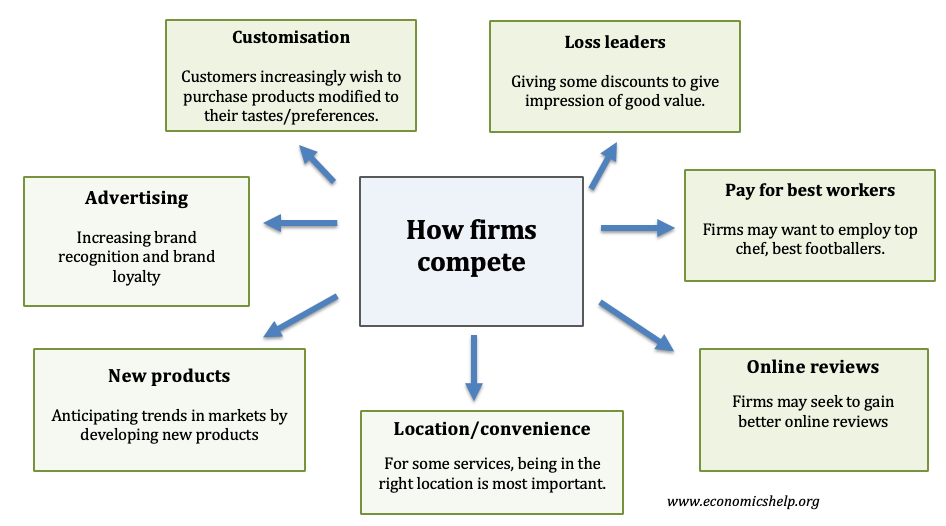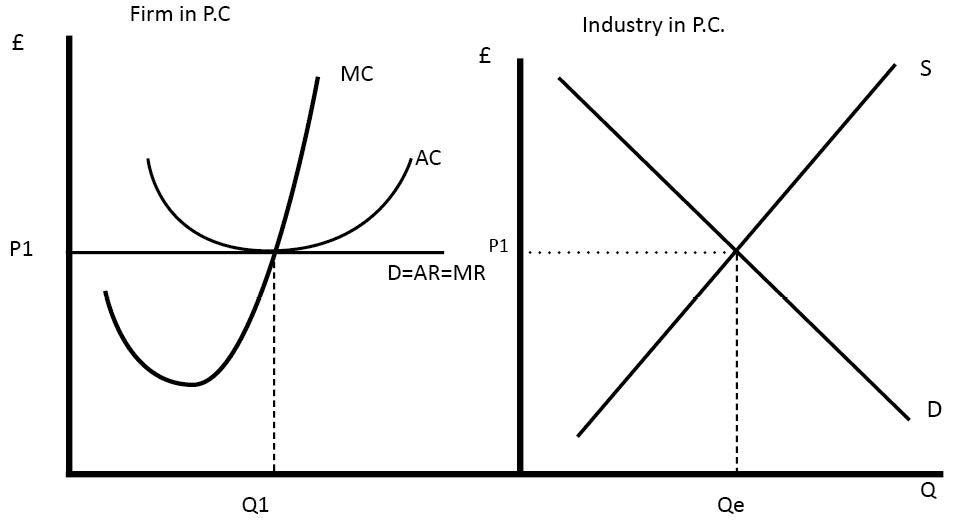Competition is an essential element of market economies. Different firms have the freedom to attract customers based on price, quality, service and convenient. The type of competition will depend on the product and market structure. For example, in a market with many traders selling potatoes, price will be a key factor. Consumers will shop around to buy the cheapest. However, for a service like a restaurant meal – the price will be only one of many factors. In this case, firms will be seeking customers based on issues of quality of food, environment and a convenient location.
Different ways firms compete

- Price. Some goods are price sensitive. For example, a good like petrol consumers will desire to buy the cheapest. Firms will struggle to differentiate the good as all petrol seems the same. Offering cut-price petrol will attract customers.
- Brand loyalty. Consumers can develop a loyalty to their favourite brand and good. The consumer knows what to expect when they go to Starbucks Coffee. Trying to increase brand loyalty is a reason why firms spend money on advertising to gain.
- Convenience. For many goods and services, convenience and being in the right location is the most important factor. It is no point selling cheap petrol if motorists have to drive many miles to purchase.
- Service For some products, the quality of the service is important. With restaurants, the price of the meal may be considered secondary to the quality of the food and the environment of the restaurant.
- Offering new products. Rather than reacting to consumer preferences, successful firms have developed new products that create new markets. For example Apple with innovative iPod and iPad.
Competition in perfect competition
Perfect competition is a theoretical market structure, in which there is perfect information and the good is homogenous. Therefore, the price is the determining factor and the model suggests that all firms will converge on selling at the market price.

In the real world, perfect competition is unrealistic except for a few products (foreign exchange markets)
Competition in Oligopoly
Most market structures are some kind of oligopoly. This is more realistic as it allows for a few firms to dominate the market. In an oligopoly, we can see more non-price competition as firms seek customers based on factors such as. Some models of oligopoly suggest prices will be stable – see: Kinked demand curve model
Loyalty card – encouraging repeat customers through discounts to loyal customers
Direct mailing – a key method of retaining customers is through gaining access to their email address and then sending targetted promotions and news about new features/products.
Ethical/charity concerns. Some firms may promote an ethical line of marketing, for example, ‘fair-trade’ coffee appeals to customers who wish to buy goods with a social conscience.
Unique selling points. In recent years, firms have concentrated on offering differentiated products and products that can be customised to consumer preferences. For example, when Henry Ford launched the Model T, he said, customers can have any product so long as it is black. But, the modern customer seeks greater specialisation. Innovative clothing companies allow customers to send in their own personal measurements to get clothes which fit, rather than generic sizes of S, M, L.
Advertising/brand loyalty. Firms spend billions on advertising because repeated exposure to famous brands can make consumers more likely to buy ‘trusted’ brands. High brand loyalty can also create barriers to entry. For example, many firms have tried to enter the market for cola, but have been unsuccessful, due to the success of Coca-Cola and Pepsi in creating strong brand loyalty.
After-sales service. For some goods, like TVs and car, offering free after-sales service can be a factor in encouraging customer trust.
Cultivation of good reviews. In an online world, good reviews are increasingly important – especially for industries like tourism. Therefore, firms have an incentive to encourage happy customers to leave reviews.
Foreseeing trends in markets. Many successful retailers have gone out of business because they were stuck with old business models. Successful firms need tremendous adaptability and innovation to move into new markets and trends. For example, retailers who successfully moved into an online presence have been more adaptable to trends in consumer behaviour.
Pay for best workers. In some industries, success may all depend on the quality of staff. For example, restaurants may want to employ the top chef. Football clubs the best footballers and managers. In other industries, firms may work hard to keep the workforce motivated by share employee schemes – giving workers a share in the firm’s fortunes.
Different forms of price competition
Firms can also use different types of price competition to attract customers.
- Premium pricing. This occurs when a firm makes a good more expensive to try and give the impression that it is better quality, e.g. ‘premium unleaded fuel’, fashion labels.
- Loss Leaders This involves setting a low price on some products to entice customers into the shop where hopefully they will also buy other goods as well. However, it is illegal to sell goods below cost, so firms could be investigated by OFT.
- Price Discrimination. This involves charging a different price to different groups of consumers to take advantage of different elasticities of demand. There are different types of price discrimination from first degree to third degree.
- Reference Pricing. This involves setting an artificially high price to be able to later offer discounts on previously advertised price.
See more at pricing strategies
Other ways firms may compete
Collusion – a way to avoid price competition – entering into tacit agreements to restrict output and fix prices. This is illegal in many countries
Preventing the entry of new firms. To retain monopoly power, firms may use limit pricing, spend money on advertising and seek to control different stages of production, e.g. retain landing slots at major airports.
Mergers – buying rivals to reduce competition
Related

What is a disadvantage to joining the EU.
You are not able to control your own laws and regulations as the European Union that you will be in when you join will control them.